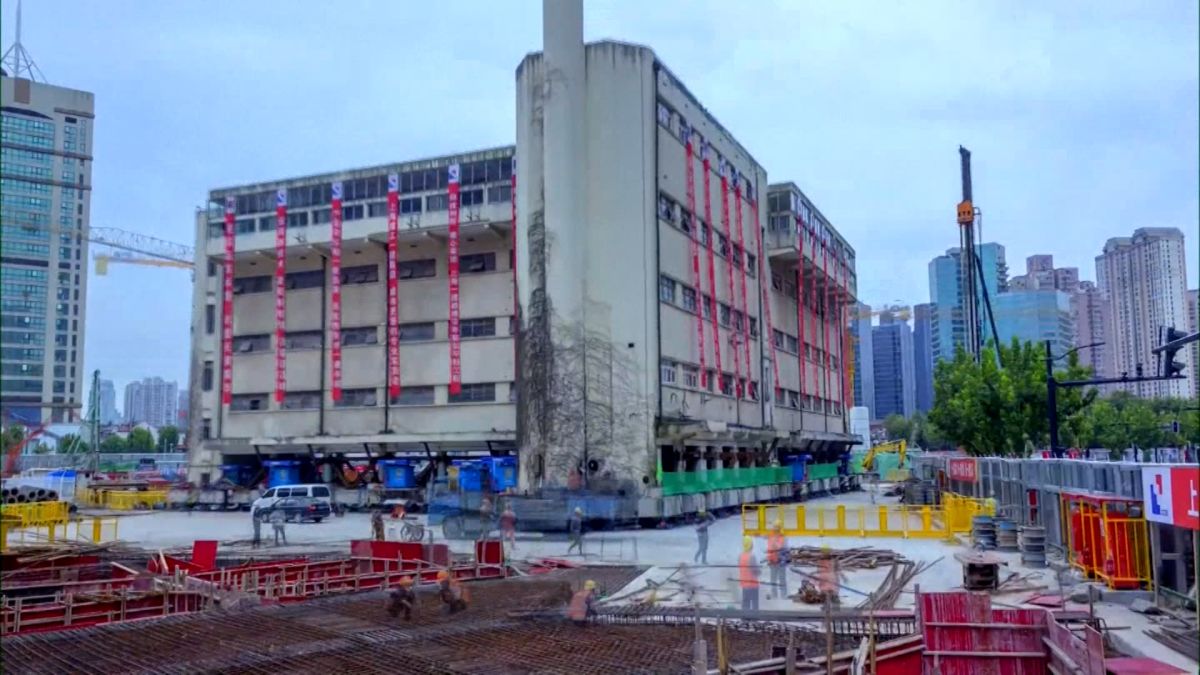85-Year-Old Heritage Building ‘Strolls’ To A New Location with Robotic Legs In Shanghai As China’s Growing Robotic Technology On The Way To Overtake Human Labors

Now in 2020, we can expect the erratic. So, would you be able to envision gigantic structures strolling around? All things considered, that is excessively far, however, that is the thing that the inhabitants in Shanghai’s eastern Huangpu area saw at the solid beginning of October. In a fantastic utilization of innovation, an 85-year-old school working in China was moved to another area utilizing mechanical ‘legs’. The Lagena Primary School was moved from its area to make space for another business and office complex. The migration was an uncommon sight as it utilized a “mobile machine” innovation. Video of the school building seeming to walk has been shared on the web and it is currently circulating the web.
The Lagena Primary School was underlying in 1935 and it must be moved to make space for new plug development. Yet, the movement didn’t include any damage to the five-story building. So, specialists from a development organization fitted the enormous structure with 198 automated gadgets that worked as its “legs”. They were fitted with wheels which permitted the development of this 7,600-ton building smooth! The structure was effectively moved on October 15. Video of the apparently “strolling” building was shared on the web and it has wondered everybody.
 Laborers burrowed around the structure to introduce these backings underneath. It took around 18 days to move the structure to its new area and now remodel take a shot at it is in progress. According to writes about CNN, it is set to turn into a middle for legacy insurance and social schooling. According to reports, this is the first run through such a “mobile machine” method that was utilized in moving a development. It is undoubtedly a work of astonishing designing abilities.
Laborers burrowed around the structure to introduce these backings underneath. It took around 18 days to move the structure to its new area and now remodel take a shot at it is in progress. According to writes about CNN, it is set to turn into a middle for legacy insurance and social schooling. According to reports, this is the first run through such a “mobile machine” method that was utilized in moving a development. It is undoubtedly a work of astonishing designing abilities.
China’s growing robotic technology, which is likely to replace human workers:
As of late, China’s focal organizers have been advancing robotization as an approach to fill the work hole. They have guaranteed liberal appropriations — to be given out by nearby governments — to smooth the path for Chinese organizations both to utilize and manufacture robots. In 2014, President Xi Jinping required a “robot revolution” that would change first China, and afterward the world. “Our nation will be the greatest market for robots,” he said in a discourse of the Chinese Academy of Sciences, “yet can our innovation and assembling limit adapt to the opposition? In addition to the fact that we need to update our robots, yet we likewise need to catch markets in numerous spots.” The walk of the machines, in China as well as around the globe, has been quickened by sharp falls in the cost of mechanical robots and a consistent expansion in their abilities. Boston Consulting Group, an administration consultancy, predicts that the cost of modern robots and their empowering programming will drop by 20% throughout the following decade, while their presence will improve by 5 percent every year.
Liu Hui, a business person in his forties, is benefiting as much as possible from China’s robot blast. In 2001, when he opened his first production line in Foshan, a mechanical city of 7,000,000 individuals in Guangdong, he began making thump offs of electric fans. As his business developed, he moved to real assembling, delivering parts for Chinese home machine brands. At that point, in 2012, recognizing an open door in a developing business sector, he hopped into the rising universe of advanced mechanics. Liu currently imports mechanical arms from providers, for example, the Swedish-Swiss aggregate ABB, and sells them on to Chinese makers, helping them incorporate the machines into their creation lines. It is a profoundly specific business. The vast majority of his clients are segment creators who flexibly engines and different parts of huge Chinese home-apparatus brands, for example, Midea and Galanz, which produce climate control systems, fridges, and then some.
The business has extended so rapidly in the previous year that Liu needs more space in his plant for all the apparatus he is collecting. He needs to store parts intended to help a $23,000 ABB robot under a shoddy shelter outside. “Things are evolving quickly,” he says. “The expense of work is rising each year, and the youngsters would prefer not to deal with the creation line as their folks did, so we need machines to supplant them.” The cliché picture of China’s production lines can even now be found in numerous spots: a huge number of individuals in long queues slouched over sewing machines or opening parts into a printed circuit board. Yet, that method of assembling is beginning to be supplanted by a more blended picture: mostly computerized creation lines, with human laborers scattered at a couple of central issues.
In the interim, China is building up its own robot creators. In September a year ago, Ningbo Techmation, a Shanghai-recorded maker of apparatus for the plastics business, dispatched an auxiliary, E-Deodar, making robots that are 20-30 percent less expensive than those created by global organizations, for example, ABB, Germany’s Kuka, or Japan’s Kawasaki. The E-Deodar processing plant in Foshan, with its bistro, relax zone, and open-plan creation line, looks more like the workplaces of a Silicon Valley tech fire up than a Chinese mechanical workhorse. “Our worldwide adversaries are truly adept at making robots yet their expenses are higher and they are not very great at understanding the necessities of nearby clients,” says Zhang Hong Lei, the organization’s kid, spiky-haired specialized chief.
“The cost of labor is rising and young people don’t want to work on the production line as their parents did” – Liu Hui, a Chinese entrepreneur
China itself isn’t insusceptible to the negative outcomes of mechanization. In excess of 40% of its 1.4 billion population actually live in the open country, numerous in neediness, having profited just possibly from the metropolitan monetary wonder. However, the legislature is wagering that the advantages of advancing front line assembling will exceed the harm from the potential positions lost. The mechanical technique reported by Beijing a year ago — known as Made in China 2025 — is planned not exclusively, to improve the innovative capacity of its production lines yet in addition to help the advancement of Chinese brands universally. Chow, the HSBC expert, says that as Chinese organizations attempt to expand their fares to ease the effect of the homegrown stoppage, they are probably going to zero in additional on the nature of their items: “Frequently some portion of that improvement is a superior creation measure, including advanced mechanics.” Every year, the measure of time it takes for an organization’s interest in a robot to pay off — known as the “recompense period” — is narrowing pointedly, making it more appealing for little Chinese organizations and workshops to put resources into computerization. The restitution period for a welding robot in the Chinese car industry, for example, dropped from 5.3 years to 1.7 years somewhere in the range of 2010 and 2015, as indicated by estimations by examiners at Citi. By 2017, the recompense time frame is a gauge to a therapist to simply 1.3 years.
As China and other mechanical pioneers construct more and better robots, the assignments they can take on will grow. Butchery, for instance, was for quite some time considered such expertise that machines would battle to create, as a result of the requirement for cautious hand-eye co-appointment and the control of non-uniform pieces of meat. However, Sirkin has watched robots eliminated the excess of meat considerably more effectively than people, on account of the utilization of less expensive and more responsive sensors. “It’s getting financially doable to utilize machines to do this since you spare another 3 or 4 percent of the meat — and that is worth very much on a creation line, where you can move rapidly. “There are things that people can show improvement over robots,” he adds. “Yet, they are getting less and less.”




